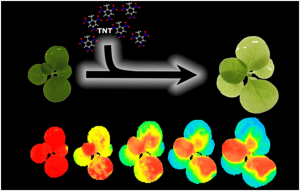What do locks, alarms, TSA screenings, guard dogs, and plants have in common?
Each can deter danger.
Yes, you read that right. Plants can make stuff safer. In fact, NOVA’s technology aficionado David Pogue explored cutting-edge examples of some leafy lifesavers in his PBS program, Making Stuff: Safer (airdate 11/6/13). So beyond thorns and prickly hedgerows what’s cutting-edge about plant security? Plenty:
Plants Stop Fires
Pogue joined professional firefighters to manage some explosive situations while testing a new firefighting product. The product is an environmentally-friendly gel that squelches fires faster than water or foam. It stops fire spread by keeping endangered plants, forests, and valuable crops from igniting. And it’s made from simple cornstarch. Once researchers finalize a more efficient liquid version for sprayers and the USDA Forest Service product certification process is complete, the corn kernel’s protective endosperm – the basis of cornstarch – not only will step into the line of fire but actually will stop it in order to protect other plants and people from dangerous flames.
Plants Find Bombs
When the US Defense Threat Reduction Agency (DTRA) needed innovative safety options ASPB member Dr. June Medford (Colorado State University) offered one based on the fact that plants cannot run from threats so they meet them head-on. Medford Lab assistant, Dr. Diane McCarthy, explains, ‘Plants are not just green things that sit around and do nothing. They are complex organisms that have evolved interesting strategies…to survive without moving. In our lab we take advantage of some of those strategies, such as complex signaling and response systems, and adapt them for new uses.’

The Medford Lab adapted the receptors (proteins) of the Arabidopsis plant to sense and respond to the presence of dangerous substances. Specifically, when airborne TNT contacts Arabidopsis the leaves turn white. McCarthy adds, ‘By modifying plants to perform new functions, we are taking important first steps towards a new era in plant biology. In the future, plants with synthetic gene circuits may help us to sustainably produce better medicines, biofuels, and other products.’

Current benefits include easier maintenance than for bomb-sniffing dogs or robotic detectors. Also, research indicates that a ‘degreened’ or white Arabidopsis plant can reset and be used again. How fitting that a plant-based safety device is evergreen.
Plants Will Save the Day
One heroic safety innovation rooted in plant biology is headquartered in an underground cavern on a Norwegian island near the North Pole. The Svalbard Global Seed Vault preserves duplicate samples of seeds from the world’s genebanks. This savings and loan superhero for seeds exists to defend against starvation or unrest in the case of individual genebank failure or large-scale crises that interfere with global seed access. Plant geneticists and other experts work to screen, store, and update seeds representing a critical component of the world’s food crops. In our September 30th post, conservationist Cary Fowler explains exactly how Svalbard keeps the world safer with seeds.
Plants Inspire the Next Generation
David Pogue and the plant-safety innovators mentioned here have done their part to show that plants can be integral to deterring danger. Now it’s your turn. Share this post with any middle or high school students in your world. Encourage them to consider the ubiquitous importance of plants and perhaps to enter an essay in the 2014 DuPont Challenge about using science and innovation to resolve impending food, energy, and protection issues. Cultivating such critical thinking today will help the youth you know plant a seed for a safer future.
